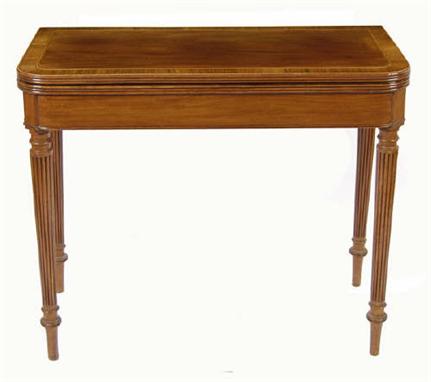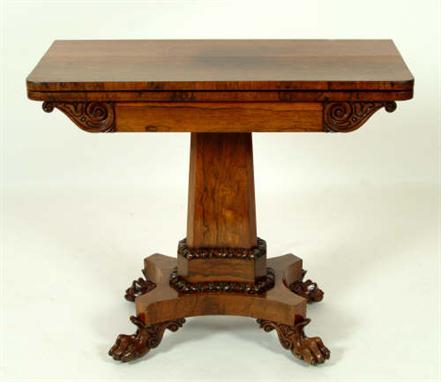We found 32021 price guide item(s) matching your search
There are 32021 lots that match your search criteria. Subscribe now to get instant access to the full price guide service.
Click here to subscribe- List
- Grid
-
32021 item(s)/page
A George IV mahogany card table, the 'D' shape hinged and swivel top with a baize lined playing surface above a plain frieze with an applied carved palmette, on a turned column stem to a quatreform base with applied rondels, disc feet to brass caps and castors, 29.5in (75cm) h, 34.25in (86.8cm) w, 17.5in (43.6cm) d. Top slightly bowed.
A well-documented inter-war O.B.E. group of six awarded to Senior Assistant Secretary F. N. Smith, a long served staff member of the Home Office and Admiralty, late Lieutenant & Observer in the Royal Naval Air Service and Royal Air Force The Most Excellent Order of the British Empire, O.B.E. (Civil) Officer’s 1st type breast badge, silver-gilt, hallmarks for London 1927, in its Garrard & Co. case of issue; British War and Victory Medals (Lieut., R.A.F.); Jubilee 1935; Coronation 1937; Coronation 1953, these last three in their card boxes of issue, together with a Ministry of Pensions’ bronze-gilt football prize medal, dated 1924, and a rather unusual presentation ‘miniature light house ‘, gilt, in its fitted case of issue, and a set of related miniature dress medals, the second and third with official corrections, good very fine and better (14) £300-350 O.B.E. London Gazette 1 January 1931. Frank Nevill Smith, who was born in June 1896 and educated at Wyggeston School, transferred into the newly established Royal Air Force from the Royal Naval Air Service in the rank of Lieutenant & Observer in April 1918, having, it is believed, seen service in seaplanes. Following his demobilisation, and a brief appointment at the Admiralty, Smith joined the Ministry of Pensions, in which capacity he served as Private Secretary to Sir George Crystal, the Rt. Hon. F. O. Roberts and Major the Rt. Hon. G. C. Tryon, the latter during the Baldwin Government, services that resulted in the award of his O.B.E. in 1931, which insignia he received at a Buckingham Palace investiture held in February of that year. Next employed as a representative at the British Ministry of Pensions in Ottawa, Canada, he returned home to a take up a new appointment in the Ministry of Health in 1935. Two years later, he transferred to the Home Office, and served as Principal Private Secretary in the Fire Service Department for much of the Second World War, ‘when he shared the perils of the firefighters during the 1940-41 blitzes, at the stations and on the fireground’. Shortly before the end of hostilities, however, Smith gained another appointment in the Admiralty, and served as Secretary to the British Admiralty Technical Mission in Ottawa 1944-46, and as Civil Adviser to the British Admiralty Delegation in Washington 1946-47. Indeed he remained employed by Their Lordships until his retirement in 1957, latterly having served back in the U.K. as Head of Department in the Admiralty’s Labour Branch. And as evidenced by accompanying documentation, he came into regular contact with influential civil servants, politicians and senior naval staff throughout this period, among the latter being Admiral of the Fleet the Earl Mountbatten. Sold with a large file of original documentation and photographs, the latter including several pages from an old album with approximately 25 images of Great War aircraft and other subject matter, and around 20 later images, largely relating to his time with the Admiralty in the 1940s and 50s; together with Central Chancery O.B.E. investiture letter, dated 6 February 1931; assorted correspondence, including letters to Smith from Lord Hailsham, Sir John Lang, G.C.B., Secretary of the Admiralty, Sir Richard Powell, K.B.E., C.B., C.M.G., a Deputy Secretary at the Ministry of Defence, congratulating him on his handling of the ‘Malta Arbitration case ‘in 1949, and the Rt. Hon. Frederick Roberts; two old carbon copies of letters written by senior courtier Sir Alan Lascelles, K.C.B., K.C.V.O., C.M.G., M.C., the first regarding the death of King George V and the second the abdication of Edward VIII, the latter with no punches pulled, and presumably retained by Smith while employed at the Home Office; formal invitations and menus (12), one or two of the latter bearing signatures of fellow guests, and including a table plan of an evening at Forte’s Restaurant, when Smith was seated next to Mountbatten, in addition to a Trafalgar Night Dinner at Greenwich in the presence of the Queen and the Duke of Edinburgh, 21 October 1955; and assorted career newspaper cuttings.
A Regency rosewood card table the rectangular foldover top with a gadrooned edge and revealing a circular red baize inset, the square tapered support with shell carved panels and ending in a quatreform base with four moulded hipped sabre legs with brass caps and castors 92cm wide, 77cm high, 46cm deep
A Japanese Meiji period silver coloured mounted table playing card cabinet, two character signature, 'jungin' (pure silver) character mark, lightly hammered overall, the top with a swing handle and four inset ivory 'playing cards' (three detached), the door and sides with wisteria, chrysanthemum, irises and other flowers in relief, the carved ivory interior with three wood lined drawers, 10cm (4in) high, 12cm (4.75in) wide, 9cm (3.5in) deep
AN EDWARDIAN MAHOGANY FOLDING CARD TABLE of demi lune form with stringing and painted with ribbons and floral festoons, the baize line moulded edged top with central portrait medallion hanging from a floral festoon, plain frieze, raised on square tapering legs and waisted square feet, 33 1/4" wide
A Regency rosewood fold-over card table, the curved rectangular top inlaid with brass stringing above a frieze decorated with inlaid fleur-de-lis and anthemion motifs, raised on an slightly flared square column and four sabre legs, carved with projecting acanthus leaf shoulders and rosette knees, terminating in brass paw caps and castors, width approx 92cm.
An early 19th Century Dutch marquetry inlaid walnut rectangular card table, profusely decorated with flower and leaf panels, borders and sprays, the top with a beaded edge and hinged to reveal a surface inset with baize above a shaped apron and a reeded baluster column terminating in shaped tripod legs, width approx 84cm.
A Victorian walnut card table of shaped outline, the baize lined folding top veneered in figured walnut, the apron fretted and carved with cartouche and scroll work to front, on four bold scroll supports with turned centre finial and quadruple splayed supports with scroll toes and castors, 36ins wide x 28ins high
-
32021 item(s)/page















































